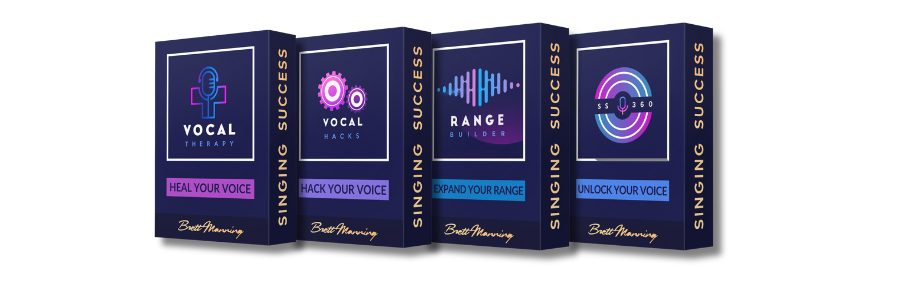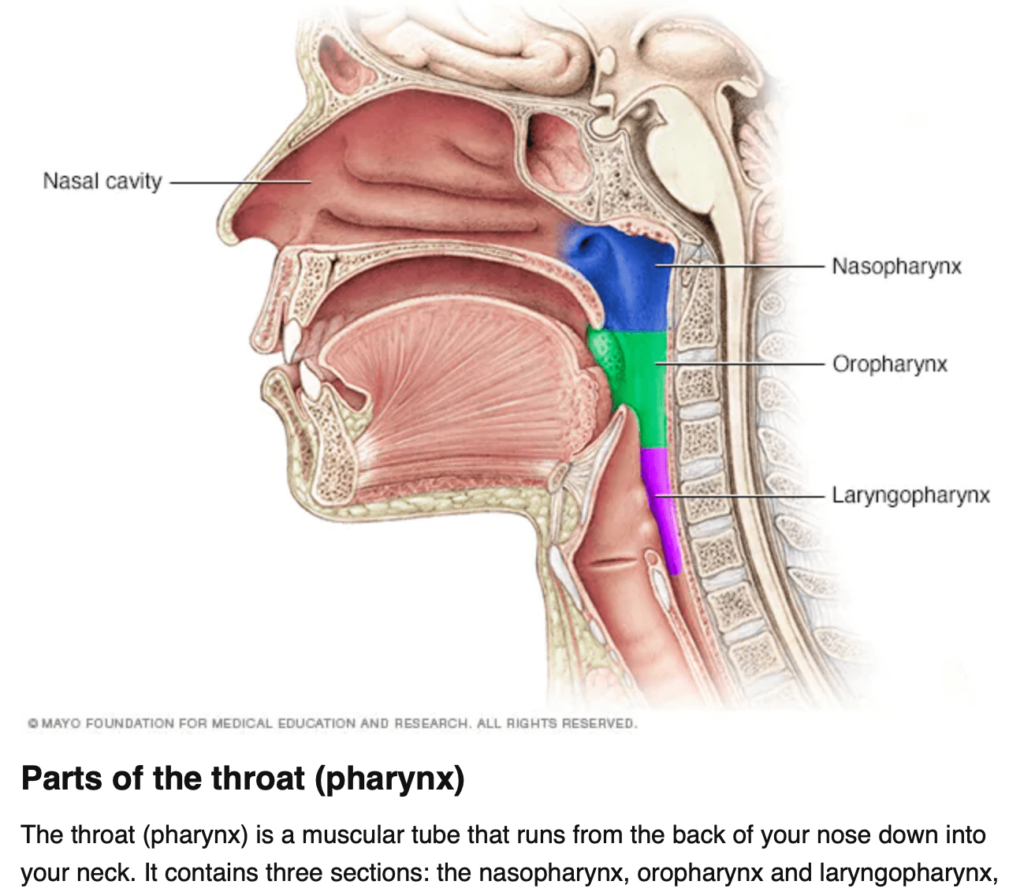Did you know there are 3 types of beginners that come to our vocal studios for vocal lessons? Yes, a beginner may have been singing for decades. A beginner may even have a song on top of the Billboard charts. All singers need vocal exercises. Determining which type of beginner you are will help you understand what exercises you’ll need to start with.
Now–not all exercises are created equally. The wrong methodology wastes time, talent, and treasure. So before you frustrate yourself, I’ll be showing you the fastest pathway to finding your voice. But first…. the 3 types of beginners:
Fast-Track Your Success!!

VIP Membership includes:
- Exclusive Facebook Group
- Interact with our vocal coaches–ask them YOUR question
- Live warmups
- Masterclasses and Q&As with Brett Manning and his guests
- SS360 QuickStart Program
- SS360 – The FULL Systematic Vocal Course
- Vocal Hacks
- Range Builder
- Mastering Mix
- Mastering Harmony
- Mastering Vibrato
- Vocal Therapy
- Plus…exclusive content only found here all along the way!
You can struggle on your own, or you can get direct access to the Nashville Coaches who have launched some of the biggest names in the music industry.
Type 1: Never Sang Before
There’s a segment of the population who’ve thought about the massive embarrassment of actually ‘trying’ to sing out loud, so they shrink back to avoid humiliation. They’ve never actually tried to learn to sing or deliberately practiced a song in their lives.
If you’re one of these singers, you’ve most definitely never done any kind of vocal exercise. You are in for a treat!
Type 2: A Singer Who’s Never Done Vocal Exercises
There’s a whole subculture of musicians who wouldn’t dare think of doing vocal exercises, who prefer to “sing naturally,” and some of these singers are pretty dang good. But–for some of them… well, “natural” isn’t working out for them.
However, even the best natural singers will have struggles. Because seasoned professional vocalists often struggle as well.
It’s like a pro athlete. Natural is good. But coaching and training turn natural into great!!!
Type 3: Professional Singers Who Need to ‘Fix’ Their Voices
Many of my clients are those with record deals who’ve had anywhere from 2 to 20+ vocal coaches and countless singing lessons. Some of them feel like giving up, thinking that they’ve maxed out their potential.
As mentioned above, not all techniques lead to success. The best vocal sound you can produce is a result of daily vocal exercises that maximize vocal ability and minimize vocal strain.
A professional singer is just as likely to need additional training to “course correct.” The best vocal warm ups are often new singing exercises they’ve not seen.
So all 3 categories of beginners will be doing “beginner” singing exercises and will share a similar warm up pathway, though, for some, it might happen faster because of experience or… experience might slow progress because bad habits have caught up with them.
Warm ups are not meant to be a race. They’re part of a daily vocal workout plan which is to become habitual.

Understanding Your Singing Voice
Singing can be simply understood as sustained speech, melodic speech, or acting on pitch. But what makes a great singing voice? Here are a few of the basic features:
PDQ of the Voice!
Not “Pretty D*** Quick. Instead, Pitch, Duration, and Quality.
Melody is simply singing certain pitches or notes in a certain timing. This is why rhythm should be stressed for beginning singers. This will instantly make you more melodic. But your pitch cannot be off. Some have referred to these folks as tone deaf, but as I’ve explained in many of my earlier articles and blogs, NO ONE is tone deaf unless they are completely deaf.
Instead, they sometimes lack the coordination to “find” the pitch and coordinate in their voices. This is easily fixable by using the best vocal warm ups.
Singers need freedom, and for that, they need a method that drastically reduces the amount of musculature or strain often employed in the tone-making process. The duration of the voice simply refers to your endurance. The conditioning of the vocal muscles through utilizing the best vocal warm ups will give you the strength and stamina to sing all night long without hurting or losing your voice.
Tone quality is probably the greatest common desire that singers are seeking once they can sing on pitch. The interesting thing is–the vocal warm ups we teach at my studio and in my online courses give singers all three of the PDQ that singers desire. Because great technique inevitably unlocks all 3 at the same time!!!
Part of tone quality is vibrato, which is that wavering or oscillation between 2 pitches and 2 pressures in the vocal folds. Think of the freedom of a flag waving in the wind and then consider how your tone can be freed up, too, with the flow of air across the flexibility of the voice. You can read more about vibrato at the bottom of the page for my ‘Mastering Vibrato’ course.
Finally, I want to encourage you that your voice can strengthen and coordinate pretty quickly with daily practice and solid coaching. Some ear training may be necessary as well.
The goal is to find your unique style by understanding all the parts of your voice and then making those parts musical and interesting!
What is the Singing Voice?
Part of improving is understanding your voice type. There are 4 basic voice types:
SATB- the 4 Voice Classifications
Soprano- the highest female voice. Usually, these vocalists have high speaking voices and a lighter, brighter vocal quality. Most women are sopranos.
Alto- the lowest of the female voices. These are the ladies who speak relatively low and have a warm or darker quality of voice. True altos are very rare. A mezzo soprano is a singer who fits in the middle of soprano and alto!
Tenor- the highest male voice. They usually have high speaking voices and brighter tone quality. Most men are tenors.
Bass- the lowest of the male voices. These are the men who speak extremely low and have a warm or darker quality of voice. True basses are extremely rare. A baritone is a singer who fits in the middle of tenor and bass!
In the singing courses I’ve written, we call out the pitches so that you know where to begin singing based on your voice type.

How the Singing Voice Works
The voice box, more technically named “larynx,” is where the vocal cords (notice it’s not ‘vocal chords’ because the ‘ch’ refers to a musical chord or triad) are housed horizontally. Air passes through them, causing them to vibrate, which creates different frequencies producing different pitches.
The stretching and eventual “zipping up” or “dampening” of the vocal cords is what changes pitches from the lowest note to high notes.
The spaces above the larynx—producing resonance—include the pharynx (located in the back of the throat and producing a brassy, bright, and sometimes whiny tone), the roof of the mouth or hard palate, and the nasal cavity. Resonance is the distinctive tone that makes your voice identifiable.
Articulation of vowels and consonants is formed by the shape of your mouth and articulation of your tongue, teeth, and lips.
Respirator- the lungs, which are controlled mostly by the diaphragm, are responsible for the air support to the larynx. Breath control, also known as breath support, is needed to increase and decrease the volume of the voice. Vocal power is directly affected by vocal cord closure and how much you blow air or breath support.
Strong lungs, developed through aerobic exercise and weight training, as well as simple breathing exercises, can help expand lung capacity to be able to sing long phrases in one breath. Check out my “one breath-one minute” challenge on my Instagram. This is a long-term goal for sure, but it can be accomplished with daily warm ups.
Be sure to warm up your voice slowly in the beginning weeks. Take frequent breaks whenever you feel the least bit worked and allow—but don’t force—your vocal warm ups!
Build up from 20 minutes a day to one hour of comfortable singing. Exercise of any kind can be overdone. Sometimes, beginners can only do two exercises before taking a break. That’s fine. You’ll get better even faster if you start with physical activity before you start singing.
The goal, in the beginning, is to warm up your voice! Not work out or strain. More power, higher pitch, low notes, and control come eventually.
The more you focus on patience, the more you’ll feel relaxed and enjoy a great practice.
Realize that the majority of recording artists will exercise their entire body and voice to maximize their singing. They use technique to create their signature sound, and so can you!
Vocal Registers
A vocal register is a range of tones in the human voice produced by a particular vibratory pattern of the vocal folds. These registers include chest voice, head voice, and mixed voice.
More uncommon are vocal fry, falsetto, and the whistle register. Registers originate in laryngeal function.
- Chest voice: is the lowest common register that produces a tone that mainly resonates (vibrates) in the roof of the mouth internally and vibrates against the sternum or chest externally. It’s typically the voice most of use in speech. Whenever you call someone with a mild shouting ‘hey you’, you are typically in a chest voice.
- Head voice: is the lowest common register that produces a tone that mainly resonates (vibrates) in the nasal cavity, behind the soft palate internally, and vibrates against the top and/or back of the head externally. It’s typically the voice most of us use when we imitate a siren sound. Mickey Mouse and Miss Piggy speak in a comical head voice.
- Falsetto: is that light, airy ethereal sound, typically of yodeling or disconnecting purposely from chest to your upper voice. The development of a falsetto is tricky because, in most cases, a coach is needed to help you discern the difference between a falsetto and a light head voice.
- Mixed voice: This is the most elusive and coveted tone in music because it connects the chest and head voice by blending the 2 qualities at the passaggio or ‘bridge’ area of the voice, which some call the “break.”
This video from our Master coach, Chanelle Guyton, should be great for gaining an understanding of mixed voice.
Determining Your Vocal Type
Knowing who you are can help you to sing on purpose and sing with a purpose. This is tricky because you have to get real honest with yourself. Once you do, success is far more likely!
To determine your vocal type, you should start by recording yourself singing (using your voice memo on your phone is fine) and then analyzing the recording to identify the range of notes you can comfortably sing.
This can be done by using a piano or keyboard to play notes and matching your voice to the pitch. You can also try singing along to a song in your natural speaking range to see what range your voice falls into.
Once you have identified your range, you can compare it to the standard vocal ranges of soprano, alto, tenor, and bass to determine which category you fall into. It’s important to remember that everyone’s voice is unique, so there may be some variation within each vocal category.
If you’re unsure about your vocal type, consider working with a vocal coach or teacher who can provide guidance and feedback on your singing voice.

Importance of Proper Breathing and Posture
Proper breathing techniques and good posture can help you control your breath and support your voice, which in turn allows you to produce a more clear and more consistent tone.
For good, basic posture, your shoulders are comfortably back, forming a straight line between your ear, shoulder, elbow, mid-hip, and the side of your knee.
Great posture is not rigid, not lazy, but comfortably tall. Working out with weights on your posterior chain (all the back muscles, glutes, hamstrings, and calves), plus daily shoulder rolls, will make good posture habitual.
Also, allowing the lower belly to extend forward when breathing inward is a sign of good natural breathing.
Here’s a useful, free tutorial on breath control and breathing techniques.
Developing Your Vocal Range
For years, most singers have come to me because I’d developed a reputation for discovering high notes and helping folks sing their favorite songs.
But what happens when your favorite song happens to be the highest song on the radio, and your facial muscles are giving away that this song is MUCH too high for you?
Years ago, I created a program to supplement my ground-breaking flagship program titled:
The formula of vocal-friendly exercises helped folks sing over 3 notes higher immediately in most cases and a full octave increase for a few.
But something more specific than merely developing a pleasing tone and compelling style. The money notes… sing those extremely high, crowd-pleasing, epically produced tones with a voice strong enough to enrapture an audience, and you’ll be immortal.
This is why I recorded Range Builders in 2015 and perfected and released it in 2019. The descriptions of each exercise are so odd and different that I can only suggest that for everyone looking to force that one note that has eluded them: tap out. Do something different. Try Range Builders and see how fast your high notes loosen up.
Your vocal performance should have at least one high note. If you get a tickling sensation or strained feeling in your throat—even if you’re just on middle c—tap out and contact one of our certified coaches and get “unstuck” with a diagnostic session that will prescribe the best vocal warm up regimen to keep you healthy and improving.

Exercises for Expanding Your Vocal Range
Sing on the Rossini scale for the best result in coordinating the voice upwards. Also, remember this–short distance scales tend to build tone, strength, and control. Wider or longer scales tend to build (release) range.
Examples of singing exercises that can be used to expand your range are lip trills, fire engine sirens, tongue trills, edge exercises on vocal fry, relaxed neck and jaw muscles, and… wait for it… singing small. Yep! Abandon your larger sound because the vocal cords need to thin out to sing higher.
- Lip Trill- For lip trills – also called lip buzz or lip rolls – vibrate your lips by blowing air through them while making a humming sound, and gradually increase the range and duration of the trill. This is like a series p-p-p-p-p or b-b-b-b-b.
- Tongue trills are simply like rolling your r’s on a series of d’s. The letter d provides an upward pressure that helps keep the tongue snapping back or trilling while you blow air.
- Sirens- glide smoothly up and down your range while maintaining a consistent tone and avoiding strain or tension. This exercise can be done throughout the day since a piano is not needed.
- Vocal fry- Try octave jumps: use minimal breath on one note and do a relaxed jump from one octave to another. Gradually build up to higher and lower octaves.
If you can forgive the crazy hair… 😜 … here’s a cool headstart for new singers. For more systematic vocal warm ups, consider becoming a VIP member and totally exceed your own expectations!
Each exercise will rock your world, but… imagine what a different vocal warm up each day could produce for you!
Strengthening Your Vocal Cords
Let me say that strong vocal cords for singing, speaking, and overall vocal health is an integral part of confidence. The sound of your speech relies on it. Also, consider this… your sound is literally your personality externalized.
Common causes of vocal cord damage, such as smoking, excessive shouting, or improper technique, need to be considered if you really love music and want to perform at a high level.
Also, exercise of any kind should be accompanied by proper water intake, AKA hydration! Check out my hydration blog for much more specific tips as I demystify the controversies surrounding hydration.
Avoid excessive amounts of irritants like caffeine or alcohol, which can lead to dehydration.
Exercises for Strengthening Your Vocal Cords
The exercises we use for strengthening your voice can be sampled as a free resource throughout our YouTube channel. But here’s a good rule of thumb for how you’ll train your voice on a most basic level.
- Relaxed humming to warm up, making sure there’s no tension in your lips or tongue.
- Lip trills (lip buzz or lip rolls and/or tongue trills) to stretch your range and coordinate high notes.
- Make a siren sound or a light ‘weeeee’ sound to find your head voice.
- Make nasty “nays” (whiny nay sounds to connect your chest and head voices and gain mix).
- Use vocal fry to connect with the most minimal effort and to enact cord closure, especially if your voice is chronically breathy. You’ll get two birds with one stone because vocal fry will also drastically extend your range.
- Exercise your body before you sing. Exercise increases circulation and blood flow throughout the body, which is needed to warm up your voice as well as your body. It makes sense to do at least 10 minutes of near-vigorous exercise. (Disclaimer: Consult your physician before beginning any new exercise regimen.)
- Find that perfect warm up song that is super easy to build your confidence. Once you warm up with an easy song, you’ll “feel” better about yourself, and that is necessary to get better!

Maximize Your Potential
Finally, if you don’t sing already or feel like you’re not singing to your full potential, the best thing you can do for yourself is:
- Decide- to pursue excellence and don’t try to guess or determine your outcome. Your potential is often WAY beyond your imagination.
- Commit- to practicing your vocal exercises 3 to 6 times a week.
- Share- your aspirations, future vision, and your dreams with encouragers. These may include certain family members, friends, fellow musicians, your new vocal coach, and… yourself. Leave yourself a reminder on your phone to NEVER GIVE UP!
Schedule a session with one of our encouraging, talented, certified coaches. Just call or email:
615-866-1099
support@singingsuccess.com
Or…become a VIP member and do a new lesson every day!
Or….expedite your progress and DO BOTH!
Be brave, be different, be decisive.






